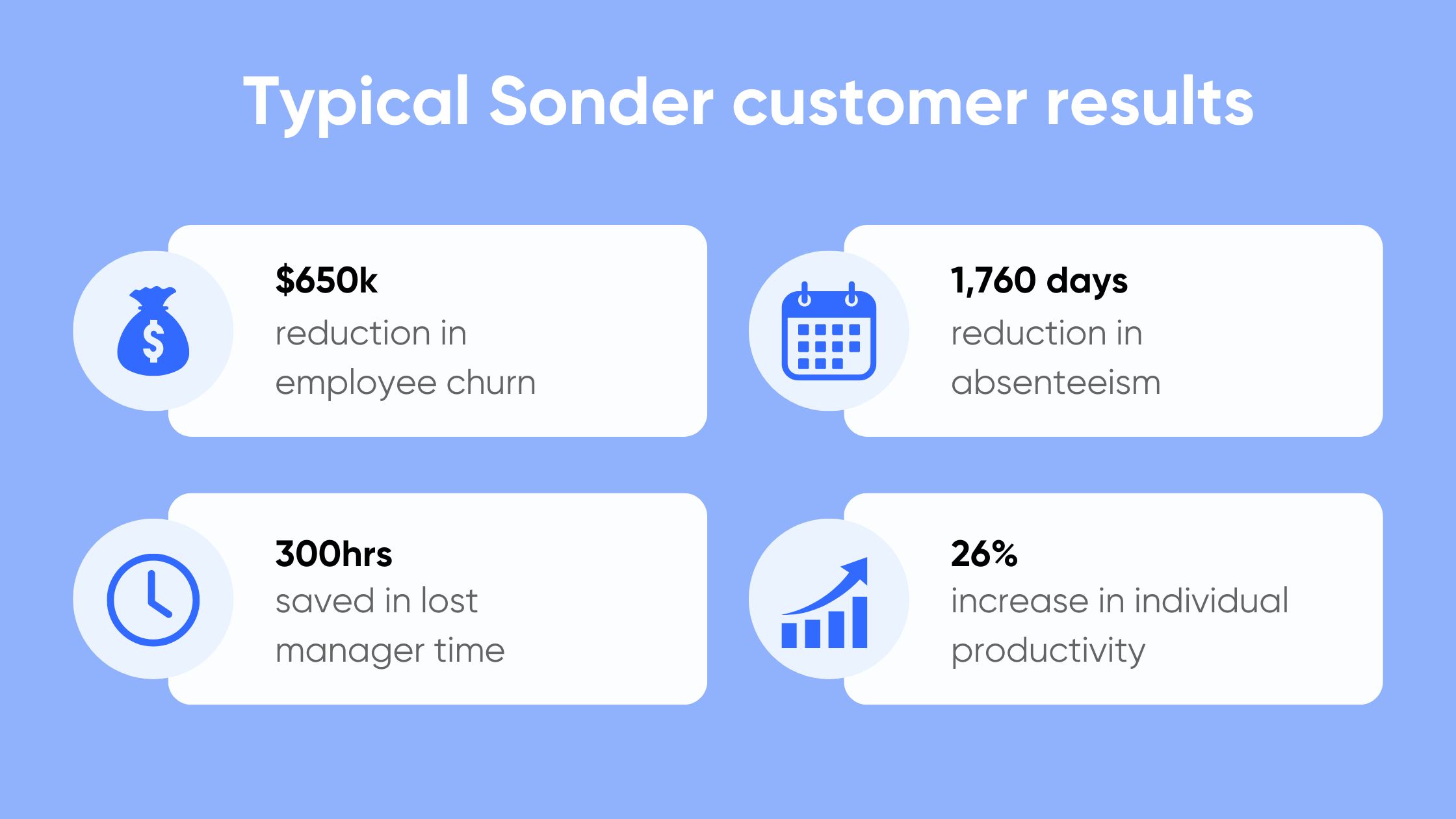The TL;DR:
- Employee Assistance Program (EAP) services help employees navigate personal and work-related challenges.
- These programs can support mental health, substance abuse, financial planning and more, helping employees thrive in their professional and personal lives.
- While traditional EAPs have been a staple in workplace support, the changing nature of work and growing employee expectations has seen the rise of alternative EAP solutions like Sonder.
In many workplaces, Employee Assistance Programs (EAPs) are an employer’s way of showing they care about their employees’ health and wellbeing. The intentions are right: traditional EAPs offer employer-funded access to support aimed at safeguarding the “emotional, mental and general psychological wellbeing” of employees.
But uptake tends to be incredibly limited-with utilisation rates as low as 5%-due to a range of factors, from a lack of awareness of what resources are available to a limited scope of care and even privacy fears.
With a focus on preventative care that goes beyond mental health alone, EAP alternatives are increasingly becoming the preferred option. In this blog, we’ll explore the benefits of EAPs for employees, why traditional EAPs are failing to meet the needs of modern teams, and how EAP alternatives are addressing these shortfalls head-on.
The scope of traditional EAP support services
Traditional EAPs offer a range of services that can be tailored to assist employees in tackling personal and work-related challenges. In theory, EAPs help employees navigate and overcome problems that might be impacting their ability to perform at work, ultimately fostering healthier, more productive workplaces.
While no two EAPs are the same, these support services tend to cover:
- Mental health services: Such as stress management skills, navigating anxiety and depression, and coping with trauma.
- Conflict resolution: Empowering managers and employees at all levels to communicate efficiently, reconcile differences and foster respectful relationships inside and outside of the office.
- Substance abuse: Supporting employees to overcome addictions such as gambling and substance abuse.
- Financial problems: Offering advice and support to reduce financial stress and build healthy money habits.
The challenge? While EAPs have long been synonymous with mental health counselling services, today’s employees expect more than just mental health support. To perform at their best, many employees want their employers to provide ongoing, preventative care and medical and safety benefits.
Limited support = low engagement
One of the key challenges faced by traditional EAPs is low utilisation. Many employees are reluctant to attend EAP sessions due to stigma, concerns around confidentiality or lack of awareness about the benefits on offer.
Plus, the limited scope of some EAPs, which often focus solely on mental health issues, can overlook other critical areas like physical health and safety. The lives of employees are complex and multifaceted, meaning they’re navigating multiple challenges at once that need to be addressed holistically.
????Sonder tip: 72% of our 10,000+ active members presented to us with more than one wellbeing issue.
Traditional EAPs are a good first step towards fostering happier, healthier teams. But when it comes to assessing the effectiveness of EAPs, there are a number of factors holding them back, including:
- Delivery: Traditional EAPs tend to be limited to only counselling sessions or referrals to third-party support providers (like financial counsellors). Plus, accessing these referrals can be complex and time consuming.
- Scope: Traditional EAPs tend to be too inflexible and limited in the scope of coverage, such as capping the number of counselling sessions available or only offering support to employees (not family members).
- Access: Traditional EAPs are often only available during business hours, with many support services only able to be accessed in person.
- Timing: Traditional EAPs are often triggered by a moment of crisis, taking a reactive rather than proactive approach, which means employees receive care too late.

In addressing these challenges, employers must re-evaluate and adapt their EAP strategies, ensuring these programs are not only accessible but also relevant and responsive to the diverse, interlinked and evolving needs of their workforce.
“As a leader, you’re often blind to smaller incidents impacting your people. One case that really brought this home to me involved an employee affected by a natural disaster. She lost her home and possessions and reached out for help. Her employer didn’t see this as a critical incident, but we did. We provided her with immediate accommodation and financial assistance. Later, this enabled her to open up about deeper issues from her past that had resurfaced due to the trauma. This case illustrates the importance of not segmenting care and staying with the person throughout their journey, not just offering an immediate response”.
Dr Jamie Phillips
Medical Director and Head of Member Support, Sonder
EAP alternatives: A better way forward for today’s employees
While traditional EAPs fall short of helping employees gain support for multiple intertwined challenges, EAP alternatives are stepping in to prevent crises before they happen.
Sonder is an EAP alternative that challenges the traditional model. Our early intervention platform provides employees with the right care at the right time. And here’s how:
- One app: It’s digital, available 24/7 and acts as a centralised hub for everything to do with your employee’s health and wellbeing-removing the guesswork of where to find all the resources that are available to them.
- Proactive resources: Access personalised check-ins, tailored wellbeing content and push notifications to inspire engagement. Sonder’s library of wellbeing resources makes it easy to integrate care into employees’ daily routines.
- Connect with accredited human support: With 24/7 live chat, employees can speak with registered health professionals day or night for real-time care. Plus, we can connect employees with a network of first responders for urgent face-to-face support.
- Complete employee care: By bringing together mental health, medical advice and safety support, employees can access exactly the care they need in one place-from smart check-ins when travelling for work, to live chats with doctors that avoid a late-night trip to the emergency room.

Importantly, Sonder can be leveraged by employees to support other members of their family-such as seeking an expert opinion from a nurse after hours when their child wakes up unwell in the middle of the night.
“Last night, my son came up in a rash. I used the medical element of Sonder and had an answer from one of the nurses in 15 minutes and the reassurance I needed. She was thorough and even followed up the next day, which I thought was wonderful!”
Sonder Member
The helps employees in a number of ways, ensuring they receive care that is:
- Holistic: Address multiple, interconnected wellbeing concerns on one single app.
- Proactive: Easily build better habits around sleep, stress management and managing mental health concerns with tailored resources in your back pocket.
- Timely: With an average 9-second response time and 24/7 live chat available, support is available whenever employees need it.
The effectiveness of EAP alternatives
Happier, healthier and more productive employees have easy access to the right care tools, support and resources they need. Alternative EAPs (like Sonder) take a proactive approach that focuses on preventing harm, enabling early intervention and quickly restoring employee health.
If there is one metric that demonstrates the effectiveness of EAP alternatives, it would high usage rates. In the case of Sonder, the average utilisation rate is 40%.
By intervening early and focusing on prevention (rather than reactive band aid solutions), typical Sonder customers experience:
- $650k reduction in employee churn
- 1,760 days reduction in absenteeism
- 300 hours saved in lost manager time
- 26% increase in individual productivity

“With Sonder, we’ve got people practically talking about their wellbeing, which otherwise they wouldn’t have done because they weren’t in a moment of distress. Sonder has enabled us to unlock a lot more engagement in wellbeing as a strategy by reaching people that otherwise we probably wouldn’t have had conversations with.”
Ben Cividin
People Manager, Charter Hall
Make the switch to a complete employee care platform
EAP alternatives go beyond mental health support to offer holistic safety and medical support, too. With a focus on proactive, preventative care, complete employee care platforms (like Sonder) are winning over some of Australia’s biggest employers, such as Woolworths Group, Team Global Express, and NRMA.
Want to learn more? Dive deeper into the world of EAP alternatives and discover how they can transform your organisation with our ultimate EAP buyer’s guide.
- Learn how to compare vendor offerings
- Discover what makes EAP alternatives different
- Gain insider tips and statistics
- Write a convincing business case
Ready to experience a modern approach to employee care? Get in touch with Sonder today to discover how our platform can benefit your organisation.



